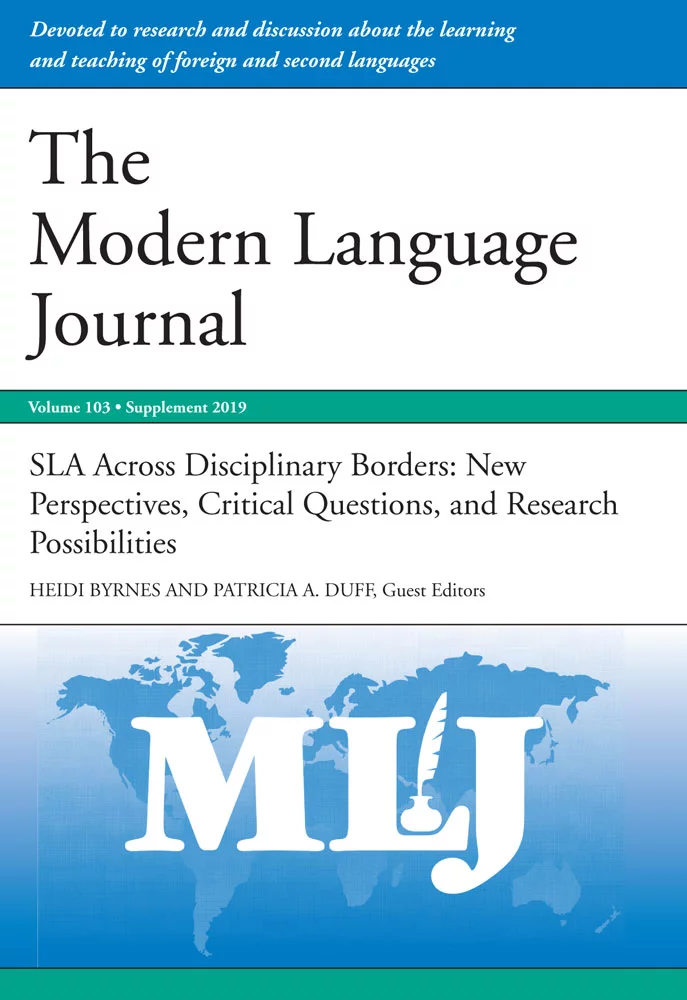【限时资源,期刊全文】The Modern Language Journal(《现代语言杂志》)2019年论文集(侵删)
1777 阅读 23 下载 2020-06-24 18:13:59 上传 12.76 MB
本期推送的是SSCI高引刊物——The Modern Language Journal(《现代语言杂志》)2019年论文集,即第103卷第1-4期的44篇论文,其中目录可在正文中查看,全文可以点击文末附件列表下载,下载链接即日
The Modern Language Journal(《现代语言杂志》)2019年论文集-共4期44篇论文(侵删)
该刊2018年影响因子:3.762
资料整理:张明辉(微信:zhangxiaojian160408)
(限时资源,即日起三天内下载有效,失效后请联系小编微信重新获取!)

| 卷号 | 期号 | 论文号 | 论文题目 |
| Vol. 103 | Issue 1 | Article 01 | Material Moments: Teacher and Student Use of Materials in Multilingual Writing Classroom Interactions |
| Vol. 103 | Issue 1 | Article 02 | Feedback‐Seeking Behavior in Language Learning: Basic Components and Motivational Antecedents |
| Vol. 103 | Issue 1 | Article 03 | Theorizing Qualitative Interviews: Two Autoethnographic Reconstructions |
| Vol. 103 | Issue 1 | Article 04 | A Bayesian Approach to Measuring Evidence in L2 Research: An Empirical Investigation |
| Vol. 103 | Issue 1 | Article 05 | Setting an Agenda for Positive Psychology in SLA: Theory, Practice, and Research |
| Vol. 103 | Issue 1 | Article 06 | L1 Transfer Effects in the Production of Generic Plurals in L2 Arabic |
| Vol. 103 | Issue 1 | Article 07 | L2 Imperfective Functions With Verb Types in Written Narratives: A Cross–Sectional Study With Instructed Hispanophone Learners of French |
| Vol. 103 | Issue 1 | Article 08 | Oral Interaction in the EFL Classroom: The Effects of Instructional Focus and Task Type on Learner Affect |
| Vol. 103 | Issue 1 | Article 09 | What Motivates Chinese University Students to Learn Japanese? Understanding Their Motivation in Terms of ‘Posture’ |
| Vol. 103 | Issue 2 | Article 10 | Translanguaging and the Transdisciplinary Framework for Language Teaching and Learning in a Multilingual World |
| Vol. 103 | Issue 2 | Article 11 | Recognizing Whose Bilingualism? A Critical Policy Analysis of the Seal of Biliteracy |
| Vol. 103 | Issue 2 | Article 12 | Engagement in the Use of English and Chinese as Foreign Languages: The Role of Learner‐Generated Content in Instructional Task Design |
| Vol. 103 | Issue 2 | Article 13 | The Effect of Perception of Teacher Characteristics on Spanish EFL Learners’ Anxiety and Enjoyment |
| Vol. 103 | Issue 2 | Article 14 | Interpersonal Factors Affecting Queer Second or Foreign Language Learners’ Identity Management in Class |
| Vol. 103 | Issue 2 | Article 15 | L2 Dynamic Assessment: An Activity Theory Perspective |
| Vol. 103 | Issue 2 | Article 16 | Using Explicit Instruction About L1 to Reduce Crosslinguistic Effects in L2 Grammar Learning: Evidence From Oral Production in L2 French |
| Vol. 103 | Issue 2 | Article 17 | Beyond the Present Indicative: Lexical Futures as Indicators of Development in L2 Spanish |
| Vol. 103 | Issue 2 | Article 18 | “J'aime to be Funny!”: Humor, Learning, and Identity Construction in High School English as a Second Language Classrooms |
| Vol. 103 | Issue 2 | Article 19 | (Re)considering the Role of Emotion in Language Teaching and Learning |
| Vol. 103 | Issue 2 | Article 20 | Elephants in the Room: An “Affective Turn,” Or Just Feeling Our Way? |
| Vol. 103 | Issue 2 | Article 21 | On the Emotion–Cognition Dialectic: A Sociocultural Response to Prior |
| Vol. 103 | Issue 2 | Article 22 | Exploring Emotions and Power in L2 Research: Sociopolitical Approaches |
| Vol. 103 | Issue 2 | Article 23 | When Elephants Fly: The Lift‐Off of Emotion Research in Applied Linguistics |
| Vol. 103 | Issue 2 | Article 24 | Sources of Definitional Problems in the Study of Emotion: Nonphysical Aspects of Mind |
| Vol. 103 | Issue 2 | Article 25 | Embracing an Integrative Approach Toward Emotion in Language Teaching and Learning |
| Vol. 103 | Issue 3 | Article 26 | Optimizing Second Language Practice in the Classroom: Perspectives from Cognitive Psychology |
| Vol. 103 | Issue 3 | Article 27 | Weighing Up Exercises on Phrasal Verbs: Retrieval Versus Trial‐and‐Error Practices |
| Vol. 103 | Issue 3 | Article 28 | Investigating Distribution of Practice Effects for the Learning of Foreign Language Verb Morphology in the Young Learner Classroom |
| Vol. 103 | Issue 3 | Article 29 | Distribution of Practice Effects in the Acquisition and Retention of L2 Mandarin Tonal Word Production |
| Vol. 103 | Issue 3 | Article 30 | Mixing Grammar Exercises Facilitates Long‐Term Retention: Effects of Blocking, Interleaving, and Increasing Practice |
| Vol. 103 | Issue 3 | Article 31 | Should We Listen or Read? Modality Effects in Implicit and Explicit Knowledge |
| Vol. 103 | Issue 3 | Article 32 | Cognitive Individual Differences as Predictors of Improvement and Awareness Under Implicit and Explicit Feedback Conditions |
| Vol. 103 | Issue 3 | Article 33 | Perfecting Practice |
| Vol. 103 | Issue 3 | Article 34 | The Desirable Difficulty Framework as a Theoretical Foundation for Optimizing and Researching Second Language Practice |
| Vol. 103 | Issue 3 | Article 35 | Optimizing Second Language Practice in the Classroom: Perspectives from Cognitive Psychology |
| Vol. 103 | Issue 4 | Article 36 | Beyond the Brain: Intercorporeality and Co‐Operative Action for SLA Studies |
| Vol. 103 | Issue 4 | Article 37 | The Social Lives of Adolescent Study Abroad Learners and Their L2 Development |
| Vol. 103 | Issue 4 | Article 38 | Foreign Language Anxiety and Foreign Language Performance: A Meta‐Analysis |
| Vol. 103 | Issue 4 | Article 39 | Individual Differences in L2 Speech Perception: The Role of Phonological Memory and Lipreading Ability |
| Vol. 103 | Issue 4 | Article 40 | Translanguaging and Public Service Encounters: Language Learning in the Library |
| Vol. 103 | Issue 4 | Article 41 | A Comparison of Advanced Heritage Language Learners’ Peer Interaction Across Modes and Pair Types |
| Vol. 103 | Issue 4 | Article 42 | Investigating the Operating Mechanisms of the Sources of L2 Writing Self‐Efficacy at the Stages of Giving and Receiving Peer Feedback |
| Vol. 103 | Issue 4 | Article 43 | The Effect of Unfocused Direct and Indirect Written Corrective Feedback on Rewritten Texts and New Texts: Looking into Feedback for Accuracy and Feedback for Acquisition |
| Vol. 103 | Issue 4 | Article 44 | Language Education and ‘Conflicted Heritage’: Implications for Teaching and Learning |
所需积分:0 分
限期开放已结束
表情
图片
附件











